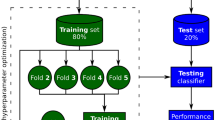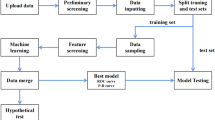Abstract
In order to improve the accuracy of predicting blood glucose levels, it is necessary to obtain details about the lifestyle and to optimize the input variables dependent on diabetics. In this study, using four subjects who are type 1 diabetics, the fasting blood glucose level (FBG), metabolic rate, food intake, and physical condition are recorded for more than 5 months as a preliminary study. Then, using data mining, an estimation model of FBG is obtained, and subsequently, the trend in fluctuations in the next morning’s glucose level is predicted. The subject’s physical condition is self-assessed on a scale from positive (1) to negative (5), and the values are set as the physical condition variable. By adding the physical condition variable to the input variables for the data mining, the accuracy of the FBG prediction is improved. In order to determine more appropriate input variables from the biological information reflecting on the subject’s glucose metabolism, response surface methodology (RSM) is employed. As a result, using the variables exhibiting positive correlations with the FBG in the RSM, the accuracy of the FBG prediction improved. Conditions could be found such that the accuracy of the predicting trends in fluctuations in blood glucose level reached around 80%. The prediction method of the trend in fluctuations in the next morning’s glucose levels might be useful to improve the quality of life of type 1 diabetics through insulin treatment, and to prevent hypoglycemia.






Similar content being viewed by others

References
Bellazzi R, Magni P, Larrizza C, Nicolao GD, Riva A, Stefanelli M (1998) Mining biomedical time series by combining structural analysis and temporal abstractions. Proc AMIA Symp 160–164
Bellazzi R, Magni P, De Nicolao G (2000) Bayesian analysis of blood glucose time series from diabetes home monitoring. IEEE Trans Biomed Eng 47:971–975
Berry MJA, Linoff G (1997) Data mining techniques:for marketing, sales, and customer support. Wiley, New York
Bhat MA, Kumar P, Bhansali A, Majumdar S, Narang A (2000) Hypoglycemia in small for gestational age babies. Indian J Pediatr 67:423–427
Fayyad UM, Piatetsky-Shapiro G, Smyth P (1996) From data mining to knowledge discovery: an overview. In: Fayyad UM, Piatetsky-Shapiro G, Smyth P, Uthurusamy R (eds) Advances in knowledge discovery and data mining. AAAI press/The MIT Press, Cambridge, pp 1–34
Iokibe T, Murata S, Koyama M (1998) Fusion of chaos and fuzzy logic, and its application. In: Proceedings of 7th international conference of information processing and management of uncertainty in knowledge-based system, pp 382–388
Kaseda C (2004) Response surface methodology using a simple algorithm. In: Lucian ML, Neamtu M (eds) Geometric modeling and computing. Nashboro Press, Brentwood, pp 341–352
Myers RH, Montgomery DC (2000) Response surface methodology. Wiley, New York
Parker RS, Doyle FJ 3rd, Peppas NA (1999) A model-based algorithm for blood glucose control in type I diabetic patients. IEEE Trans Biomed Eng 46:148–157
Pfohl M, Pfeiffer A, Schatz H (2000) Spot glucose measurement in epidermal interstitial fluid—an alternative to capillary blood glucose estimation? Exp Clin Endocrinol Diabetes 108:1–4
Sagarduy JLY, Roales-Nieto JG. (2004) Accuracy in discriminating blood glucose levels in a sample of children with type 1 diabetes. Span J Psychol 7:112–123
Sandwell DT (1987) Biharmonic spline interpolation of GEOS-3 and SEASAT altimeter data. Geophys Res Lett 14:139–142
Tsutsui H, Kurosaki A, Sato T (1997) Nonlinear modeling technique using historical data for case TCBM, topological case based modeling. J Soc Instrum Control Eng 33:947–954
WHO Study Group (1994) Prevention of diabetes mellitus. WHO, Geneva
Yamaguchi M, Kanbe S, Wårdell K, Yamazaki K, Kobayashi M, Honda N, Tsutsui H, Kaseda C (2003a) Trend estimation of blood glucose level fluctuations based on data mining. In: The 7th world multiconference on systemics, cybernetics and informatics, pp 86–91
Yamaguchi M, Kanbe S, Yamazaki K, Kobayashi M, Honda N, Tsutsui H, Kaseda C (2003b) Estimation of variability of blood glucose level based on data mining. Trans J Soc Med Biol Eng 41:43–49
Yamaguchi M, Takada R, Kambe S, Yamazaki K, Kobayashi M, Takada E, Honda N, Tsutsui H, Kaseda C (2004) Consideration of physical condition in estimation of blood glucose level via data mining. In: 26th Annual international conference of the IEEE engineering in medicine and biology society, pp 754–757
Acknowledgments
The authors thank Mr. Hiroaki Tsutsui and Mr. Nobuaki Honda at Research and Development Headquarters, Yamatake Corporation, and Mr. Shigenori Kambe and Miss Miyuki Ito at the Faculty of Engineering, University of Toyama, for their assistance in these experiments.
Author information
Authors and Affiliations
Corresponding author
Rights and permissions
About this article
Cite this article
Yamaguchi, M., Kaseda, C., Yamazaki, K. et al. Prediction of blood glucose level of type 1 diabetics using response surface methodology and data mining. Med Bio Eng Comput 44, 451–457 (2006). https://doi.org/10.1007/s11517-006-0049-x
Received:
Accepted:
Published:
Issue Date:
DOI: https://doi.org/10.1007/s11517-006-0049-x



